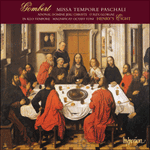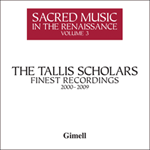
Welcome to Hyperion Records, an independent British classical label devoted to presenting high-quality recordings of music of all styles and from all periods from the twelfth century to the twenty-first.
Hyperion offers both CDs, and downloads in a number of formats. The site is also available in several languages.
Please use the dropdown buttons to set your preferred options, or use the checkbox to accept the defaults.

| Henry's Eight» More |
Gombert’s cycle of Magnificat settings is preserved in a unique manuscript source now in Madrid. The date of composition is unknown, though it may be that these were indeed the ‘swan-songs’ referred to by Hieronymus Cardanus. The fluidity of the polyphony certainly suggests a date from the composer’s maturity. The Magnificat octavi toni is not the eighth of the cycle but the third, titled Magnificat tertii et octavi toni. Since the third and eighth Psalm tones have similar intonations (ut-re-fa), Gombert has composed the work in such a way that the polyphonic (even-numbered) verses can alternate with the plainchant of either tone. However, in the event that tone three is required the polyphonic verses are slightly truncated in order that the endings accord with the mode (finishing on A), while a performance according to tone eight uses all the polyphony (finishing on G). (Clemens non Papa adopted a similar practice, except that his tone eight is the truncated form, tone three requiring the full polyphonic verse.) Uniquely among Gombert’s cycle, the polyphony of Magnificat tertii et octavi toni is organized so that each verse gains an additional voice, the first polyphonic verse, ‘Et exsultavit’, being in three parts, the last, ‘Sicut erat’, in eight, including a canon four in two.
from notes by John O'Donnell © 1997
Le cycle des mises en musique du Magnificat de Gombert subsiste dans une seule source manuscrite, désormais à Madrid. La date de composition est inconnue, mais il peut s’agir des «chants du cygne» auxquels Hieronymus Cardanus se référa. La fluidité de la polyphonie suggère assurément une date à partir de la maturité du compositeur. Le Magnificat octavi toni n’est pas le huitième du cycle mais le troisième, intitulé Magnificat tertii et octavi toni. Les troisième et huitième tons psalmiques comportant des intonations similaires (ut-ré-fa), Gombert a composé l’œuvre de manière à ce que les versets polyphoniques (numérotation paire) puissent alterner avec le plain-chant de chaque ton. Cependant, les versets polyphoniques sont légèrement tronqués là où le ton trois est requis, afin que les différences s’accordent avec le mode (finissant sur la), tandis que toute la polyphonie (finissant sur sol) est utilisée dans le cadre d’une interprétation selon le ton huit. (Clemens non Papa adopta une pratique comparable, si ce n’est que son ton huit est la forme tronquée, le ton trois nécessitant toute la polyphonie.) Fait unique dans le cycle de Gombert, la polyphonie du Magnificat tertii et octavi toni est organisée de sorte que chaque verset acquière une voix supplémentaire, le premier verset polyphonique, «Et exsultavit», étant à trois parties, et le dernier, «Sicut erat», à huit.
extrait des notes rédigées par John O'Donnell © 1997
Français: Hypérion
Gomberts Zyklus von Magnificat-Vertonungen ist als Teil eines einzigartigen Manuskriptbestandes, der heute in Madrid aufbewahrt wird, erhalten geblieben. Das Entstehungsdatum des Zyklus ist unbekannt, doch möglicherweise handelt es sich bei den Magnificat-Vertonungen tatsächlich um die „Schwanenlieder“, auf die sich Hieronymus Cardanus bezog. Aufgrund der fließenden Polyphonie ist jedoch anzunehmen, daß der Zyklus aus der reifen Schaffensperiode des Komponisten stammt. Das Magnificat octavi toni ist nicht die achte, sondern die dritte Vertonung dieses Zyklus mit dem Titel Magnificat tertii et octavi toni. Da der dritte und achte Psalmton eine ähnliche Intonation haben (ut-re-fa), gestaltete Gombert die Komposition derart, daß sich die polyphonen Verse (mit gerader Zahl) mit dem Choral beider Töne abwechseln können. Ist jedoch der dritte Ton erforderlich, so werden die polyphonen Verse leicht gekürzt, damit die Differenzen mit dem Modus (auf A endend) übereinstimmen. Bei einer Ausführung mit dem achten Ton kommt hingegen die gesamte Polyphonie zum Einsatz (auf G endend). (Clemens non Papa übernahm eine ähnliche Praktik, mit der Ausnahme, daß seine gekürzte Form der achte Ton war, während der dritte Ton den vollen polyphonen Vers verlangte.) Der polyphone Aufbau von Magnificat tertii et octavi toni ist einmalig in Gomberts Zyklus, da jeder Vers eine zusätzliche Stimme gewinnt, wobei der erste polyphone Vers „Et exsultavit“ dreistimmig und der letzte Vers „Sicut erat“ achtstimmig ist.
aus dem Begleittext von John O'Donnell © 1997
Deutsch: Manuela Hübner
 Gombert: Missa Tempore paschali & other sacred music Gombert: Missa Tempore paschali & other sacred music‘This second instalment of Gombert from Henry's Eight is cause for celebration. Gombert has found worthy champions’ (Gramophone) ‘A magnificent piece … beautifully poised singing’ (BBC Music Magazine)» More |
 Sacred Music in the Renaissance, Vol. 3 Sacred Music in the Renaissance, Vol. 3The third of three volumes featuring The Tallis Scholars' finest recordings, one for each decade, and each offering over five hours of the award-winning performances that helped establish Renaissance Polyphony as one of the great repertoires of we ...» More |

